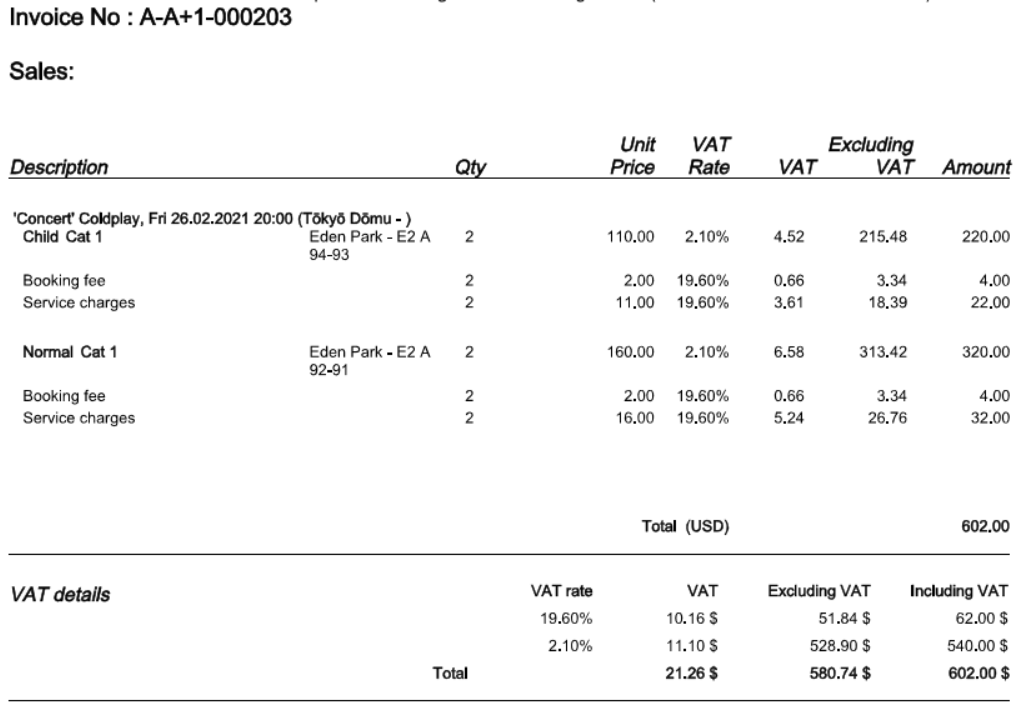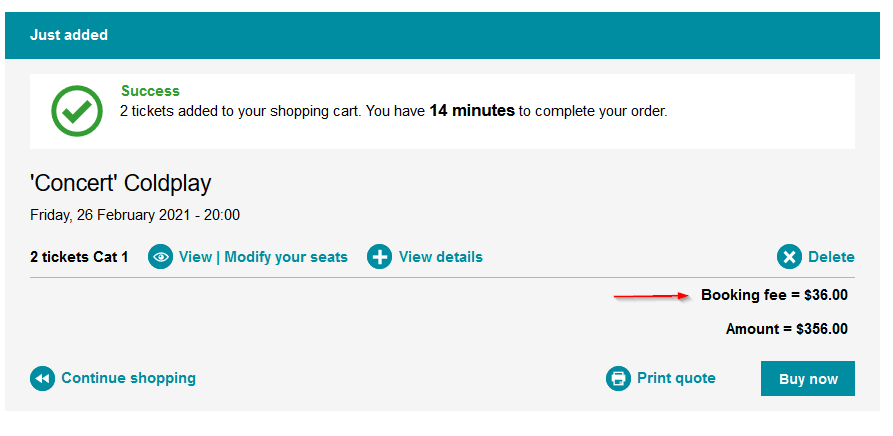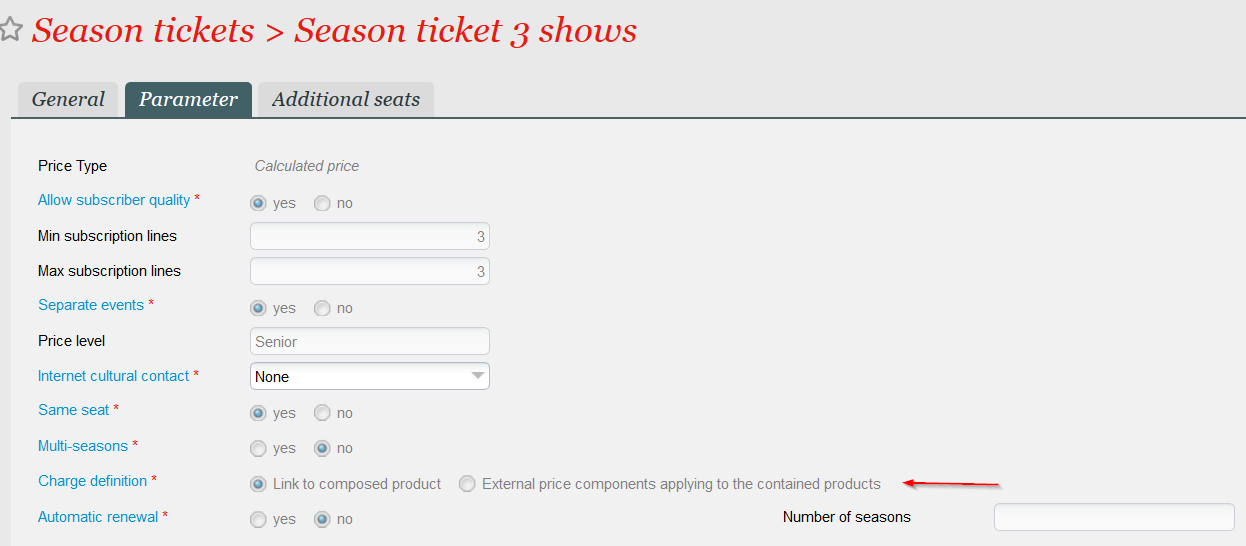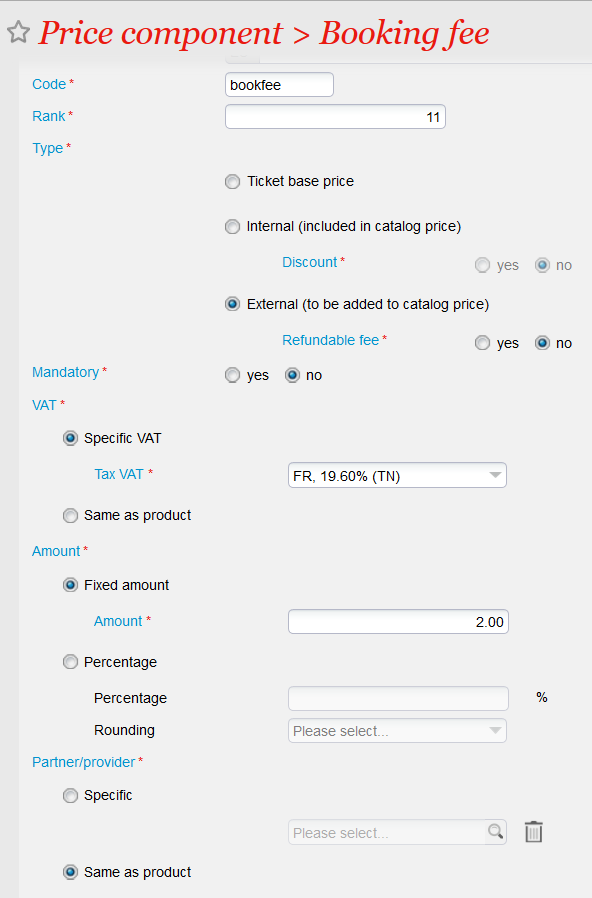NEW V3.9 SecuTix already provides internal price components in order to break down the catalog price, for example to compute the amount due to an event producer or to a distributor. A new type of price components, called external price components, allows you to define price components who come in addition to the catalog price. External price components bring several advantages compared to simple charges:
Solution
Sales on Box Office
The total amount of the external price components is displayed in the "Fees" column. You can see the detail of this amount by hovering the mouse on it.
Refund of external price components
External price components are refunded according to the following rules:
- If the refund has been requested by the organization (for example, a performance has been cancelled), all external price components are refunded.
- If the refund has been requested by the end customer, external price components defined as refundable are refunded.
- The operator may override above rules by unchecking the check box refund charges. In that case, no external price components are refunded.
Display on documents
All external price components are displayed in the Description section of the document. as illustrated below. Simple charges will be displayed in the same way. In other words, there will be one simple charge line for each item and tariff of the order. Until now, simple charges concerning the same item but different tariffs were grouped together.
The external price components may also be displayed in the VAT details by setting the flag showVATBreakdownPerPriceComponent to true. See Price breakdown in invoices and other documents for further details.
Display on reports
Revenue information related to external price components are available in all reports belonging to the domain (sub-topic) Summary of fees. A new fee type, called External price components, has been added. The fee type Price components has been renamed to Internal price components to avoid any confusion.
The reports provide the same features as for the internal price components:
- Selection of one or more external price components
- Display the external price component in the generated report
- Group by external price components (for example to display the total revenue for each external price component during a given sales period)
Sales on Ticket Shop
The total amount of external price components is displayed in the same way as simple charges: they are gathered under the label Booking fee.
External price components and simple charges
Coexistence between price components and simple charges
The new feature is fully compatible with simple charges. As a result, you can benefit from the advantages of both features by defining simultaneously external price components and a simple charge for the same product. The behaviour of the system will be quite straightforward:
- The total fee amount (displayed for example on the Ticket Shop and Box Office) includes both simple charges and external price components
- The fee details (for example in the documents or when hovering the mouse in the Box Office on the fee column) displays both simple charges and external price components in a similar way
- The reports of the domain Summary of fees distinguish between simple charges and external price components as they belong to two separate fee types.
The only exception to above principle concerns the season tickets and packages. You can decide whether you want to:
- Define simple charges at composed product level, no external price components being applied
- Apply the external price components already defined for the products contained in your composed product. In that case, no simple charges will be applied on the composed product itself.
Example:
- A season ticket contains two events E1 and E2. You have already defined an external price component for these events. To keep it simple, let us consider that this external price component has a fixed amount of 2€.
- When setting up the season ticket, you may choose between:
- Defining a simple charge applying to the whole season ticket. For example, you may define a simple charge of 3€. The total fee amount applied to the season ticket will be 3€ since the external prices component defined for E1 and E2 are ignored in this case.
- Reusing simply the external price component defined for E1 and E2. This will lead to a fee of 2€ for each event, meaning a total of 4€.
Provided features
The table below compares the features provided by the simple charges and the external price components. This table represents the current state. Additional developments are planned on the external price components in the next releases.
| Simple charges | External price components | |
|---|---|---|
| Scope | ||
| Supported product families | All product families except open products, services, vouchers, donations, transport | All product families for which a price breakdown may be defined: events, competitions, visit pass, time slot pass, open pass |
| Supported operation types | Booking/selling, option, organization exchange, customer exchange | Booking/selling |
| Amount definition | ||
| How are the amounts set-up? | Separately from the price grid | Together with the price grid |
| Default computation rule | Yes | Yes |
| Amount may depend on tariff | Yes | Yes |
| Amount may depend on seat category | No | Yes |
| Amount may depend on sales channel | Yes | Yes |
| Amount may depend on advantage | Yes (but requires a workaround) | Yes |
| Amount may be modified by operator | Yes (you can define for each tariff if the amount is modifiable) | No |
| Miscellaneous | ||
| Enable fee by default at sales channel level (applies by default to all products of a given product family, may be overridden) | Yes | No |
| Multiple fees may apply simultaneously to the same product | No | Yes |
| The fee may be assigned to a provider for accounting purpose (documents and reports) | No | Yes |
| Define in the set-up whether a fee may be refunded | No | Yes |
Further developments
Following developments are foreseen in the next releases of SecuTix:
- Grouping of external price components while displaying them on the Box Office, Ticket Shop or on documents. Define external price components in detail to match your accounting needs but present a simplified view of these external fees to your customers.
- Allow your operators to modify the fee amounts.
- Extend the price breakdown to services, fixed price season tickets and memberships, thus providing the external price component feature to these additional product families.
Getting started
Setting up the external price component
External price components are set-up exactly in the same way as internal price components. You can define if an external price component may be refunded or not, when the refund is requested by the end customer.
Entering amounts to the price grid
In order to enter the amounts of the external price components, you should follow the steps described below
Enter the catalog prices
Create the price grid and enter the amounts as usual
Create a price breakdown
You may create one or several price breakdowns, depending if the external price components amounts should depend on the sales channel or not. This step is exactly the same as for the already existing internal price components. Note that you have to include a ticket base price into your price breakdown even if you don't use inside price components.
Select the price components to be used by the price breakdown
You may select internal price components, external price components, or both. You can override the default computation rule.
Modify the individual amounts
After you have clicked on the calculate price button, the breakdown is displayed with all the amounts, based on the price component selection and computation rules above.
- The Total row mentions the total price (catalog price plus external price components) and is computed by the system
- The Catalog price has been entered previously by the operator
- The ticket base price (called PrdPrice in this example) is computed by the system by subtracting the internal price components to the catalog price. Since no internal price components have been selected in the previous screen, it's identical to the catalog price.







